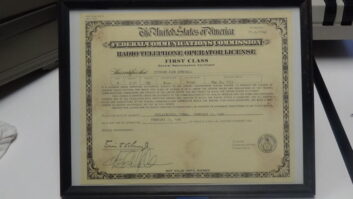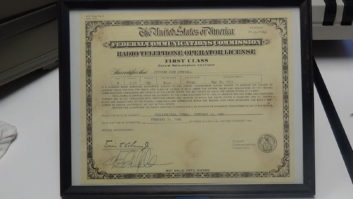We left our last installment talking about Isambard Kingdom Brunel, the obsessed mad genius.
His obsession started following a conversation in which Brunel learned that ships float not because they are made of wood but because of displacement. As long as the water displaced by the ship weighs more than the vessel, it will float. Being a trained civil engineer, Brunel instantly understood that this meant you could build a ship out of anything, as long as it displaced more water than it weighed. So he designed and built the largest iron-hulled ship up to that time, the Great Eastern.
This ship wasn’t just a copy of a “normal” ship made of iron instead of wood. No, this was the largest floating object yet. It weighed more than 18,000 tons and was almost 700 feet long and 85 feet wide. In 1858, it cost more than $250,000, many hundreds of times that value in today’s dollars.
The Great Eastern carried sails but was outfitted with a steam-powered paddlewheel system amidships. It had not one but two paddlewheels, one on each side. This allowed the ship to turn on a dime. Just turn one paddlewheel one way, and the other the other way, and it could turn a circle in its own length.
Brunel, near bankruptcy as the ship was completed, thought he would make a killing speeding passengers from London to New York. Unfortunately, it wasn’t as speedy as other regular steam-powered propellor-driven vessels. And many passengers were too scared to travel on an iron ship because they thought it would sink. Brunel’s greatest triumph became his undoing. In 1859, barely a year after its launching, he died of exhaustion at 53.
Thus the greatest ship built to that time sat in a salvage dock until it was noticed by an engineer working for Glass Elliott of Greenwich, England, one of the firms working on the transatlantic cable. Here, in the Great Eastern, was the obvious solution to one of their most pressing problems. They paid $25,000 for the ship – 10 cents on the dollar – and refitted it. For what? Why, to carry the wire!
Miles and miles
The ship could now handle three gigantic reels of wire, each over 1,000 miles long. And they could feed off the back of the ship. The size and weight of the ship helped solve the problems of rough seas or bad weather. And its ability to turn tightly was a godsend when soundings indicated obstructions below.
Only the Great Eastern could have carried the largest roll of wire made to that point (2,700 miles). In July of 1866, the Great Eastern successfully ran a cable across the Atlantic. One previous cable had worked only sporadically for two weeks before it failed.
This new cable was manufactured by Telcon, an amazingly modern name for a Victorian company. Its cable design was lighter and stronger than previous cables and consisted of seven strands of copper under three layers of gutta percha and one layer of hemp. The entire construction was covered with 18 strands of iron wire.
Not only that, but the Great Eastern then turned around and found a broken cable from a previous attempt, 680 miles from shore, and completed that. In the space of a few weeks, Cyrus Fields (1819-1892) and the Anglo-American Telegraph Company had two operating cables.
The new chief engineer, Professor William Thomson (1824-1907), later named Lord Kelvin, had a brilliant idea, e.g. publicity stunt. He assembled engineers, scientists and reporters in the transmission building on the Irish coast and sent a message to the Newfoundland station asking them to attach the two cables at their end. This gave him a 3,200-mile cable that began and ended in the same room.
He then made a simple battery, using a silver ladies thimble, a steel pin and a few drops of lemon juice. With his key and this battery, he sent a clearly discernible message down 3,200 miles of cable to the astonished multitude. This was also made possible by his invention of the “mirror galvanometer,” which could move a light beam on a wall with the most microscopic change in current on the cable.It inspired this poem by James Clerk Maxwell:
The lamp-light falls on blackened walls
And streams through narrow perforations
The long beam trails o’er pasteboard scales
With slow-decaying oscillations.
Flow, current, flow!Set the quick light-spot flying,
Flow, current, answer light-spot, flashing, quivering, dying…
There was no question that the transatlantic cable worked. It was hailed as the engineering marvel of its day. It is even more amazing to consider that one of these gutta-percha cables, laid in 1873, was in continuous use until 1953.
Copper head
Let’s take a little side-trip at this point.
While most telegraph wires were iron, those transatlantic cables, and most of the cables we use today, are copper.
Copper has been known from ancient times (see the first part of this series). In fact, the word copper goes back through Old English and Latin to the Greek word Kuprios, from Kupros, or Cyprus, which had extensive copper mining.
Copper was mined both in the Old World and the New. There are copper beads from Iraq dating back 11,000 years. And major copper mines dug by natives around Lake Superior in Michigan date to 7,000 years ago.
(click thumbnail)Gender Symbol
Did you know that the gender symbol, is the ancient alchemist’s symbol for copper? It is also the ancient Egyptian hieroglyph for ankh, symbolizing eternal life.
Did you know the best preserved of the Dead Sea Scrolls is written on copper? Did you know that the plumbing system in the Pyramid of Cheops (Khufu) in Egypt was all-copper pipe and in perfect working order when discovered in the 20th century? Did you know that Columbus’ ships were covered in copper below the waterline? (Prevents barnacles.)
But of course we’re only interest in copper wire and cable. We’ll continue our never-ending story next time.











